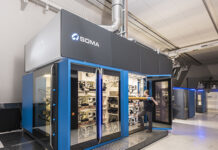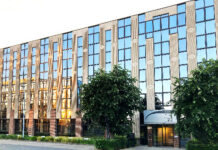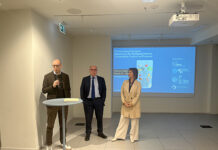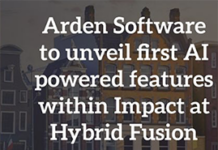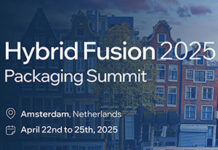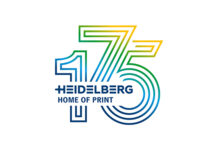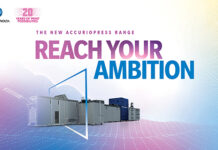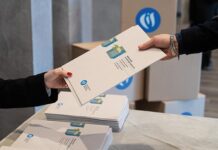Following the “Better Planet Packaging” project, Smurfit Kappa Italia presented a display entirely in cardboard, which thanks to the NFC technology it is equipped with, is transformed into an effective marketing tool and direct contact with the consumer
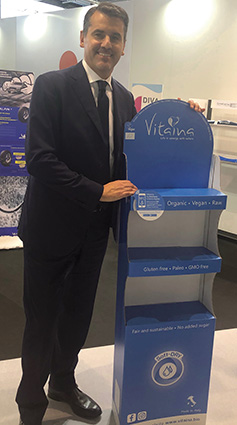
Smurfit Kappa Italia boasts a presence rooted in the Italian territory, where it operates with 26 factories. In one of these, was born the Experience Center in Pastrengo (VR), where the sustainable packaging of the future is studied and designed. This is the objective at the center of the Better Planet Packaging project launched in 2018 to offer customers innovative, functional and eco-friendly solutions.
“The display world within Smurfit Kappa is the one that pushes more towards innovation, both with creative designs and with applied technological solutions, as in the case of NFC (Near Field Communication) that allows to provide the consumer with constantly updated information, geo-localized and therefore extremely personalized, avoiding the use of additional printed supports. We have a client that produces beauty creams that has adopted this solution to display different types of cream in the same display, using NFC technology to provide targeted information to the consumer, even with a personalized analysis of their own skin through photos of their own face, to recommend the best cream. This type of interaction is very popular among consumers. Furthermore, this solution allows for the same sales campaign to have different messages depending on the geographic location”, says Gianluca Castellini, Smurfit Kappa’s CEO Corrugated Italy in front of the display in the area dedicated to the solutions that participated in the Italia Viscom Display Award 2019, where, among other things, Smurfit Group has also become the protagonist of a conference dedicated to these solutions and sustainability aspects.
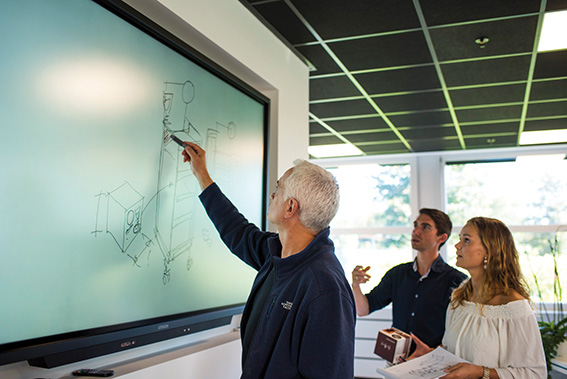 ToTheweb Display
ToTheweb Display
Smurfit Kappa Display Division, which covers a market share of over 10% on the Italian display market, has created this innovative solution in collaboration with the students of the Industrial Engineering course at University of L’Aquila.
The display presented by Smurift Kappa is the “ToTheWeb display” model, and is entirely made of cardboard, without buttons and plastic hangers, and without obviously any type of lamination that would compromise the aspects related to the recyclability of this product at the end of its cycle of life. “We are producers of corrugated cardboard and in our Group we also have a company dedicated to the recovery and recycling of raw materials, therefore we are particularly sensitive on these issues, and our commitment to the sustainability of our products starts from the design phases. From a design point of view, our customers require display solutions capable of attracting the consumer to the display, and we know how important it is for a company to sell outside the shelf”, adds Castellini.
The display is printed in offset and laminated with corrugated cardboard, with the yield of the sheet optimized to the maximum, thus limiting the waste of paper. The assembly instructions and functionality of the display unit are printed on the back, but since they are self-assembling displays, the procedure is very simple and fast.
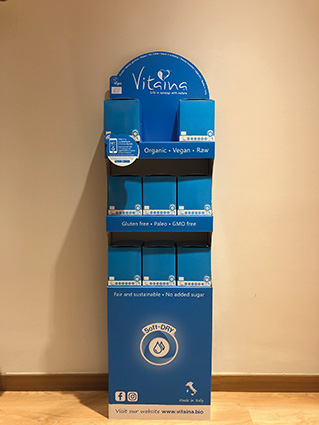 The partnership with Vitaina
The partnership with Vitaina
Partner of Smurfit Kappa in this adventure is Vitaina, a young and dynamic company from Lazio that produces dehydrated fruit: for them a very functional floor display has been created consisting of a single element, equipped with shelves that hook onto a slot at the back with no need to use glue.
The display assembly scheme is printed on the back to help point-of-sale operators without the need for instruction leaflets. So, less paper, less waste.
The Tag is placed at eye level and, in the case of Vitaina, has saved the cost of printing brochures in three languages and, since the information is linked to the web and is not present on the display, the updating costs of the exhibitor: if the promotional campaign or message changes, you have to change simply the content of the web page to which the tag is linked.
NFC technology | what it is and how it works
NFC (Near Field Communication) is a technology capable of connecting two devices using short-range wireless connectivity. Its operation is limited to a maximum radius of 5 cm between the two devices. This technology can be implemented in a display through tiny NFC tags inserted in the exhibitors.
The NFC tag, appropriately programmed, can contain a link to which various information can be found: corporate sites, e-commerce platforms, product catalogs, videos, marketing campaigns, just to name a few.
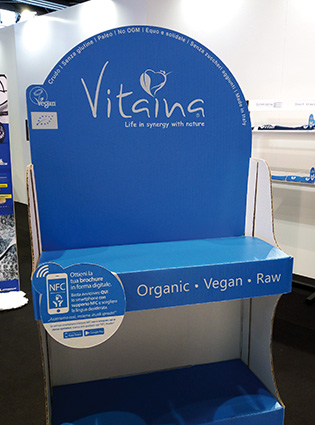
The advantages of NFC Tag vs QR code
NFC offers many advantages in comparison with the use of QR code:
- greater simplicity for the user: QR code requires to be framed well and the use of a specific application, while NFC tag requires only to approach your mobile to enable reading;
- more content: it can contain more information than QR code;
- greater speed: data transmission is much faster (about 3 seconds) and safe;
- reuse: it can be rewritten and reused for an infinite number of times with different contents each time;
- payment: can be used as a payment system, Google has already introduced it for some time in the United States;
- customization: unlike QR code that is printed and can be encoded with a single link, NFC tag can be individually programmed allowing you to customize each display with different contents; in this way it is possible to customize the content to respond to specific needs and to be able to carry out more in-depth analyzes on the results of the campaigns.




